Abstract
In this work, a small group of known extractable and leachable compounds were selected to showcase the workflows on the X500R QTOF System, using SWATH® Acquisition and SCIEX OS Software. Three workflows were demonstrated, a targeted screening workflow, a non-targeted screening workflow and finally a targeted quantification workflow.
Introduction
Extractables are chemical entities that are released when stressing a pharmaceuticals’ packaging or delivery system to determine what compounds might contaminate the drug product under atypical storage conditions.1 When testing a product for extractables, the packaging or delivery system is stressed using a range of solvents, temperatures, agitation, etc to exaggerate extraction of potential compounds to assess what can be produced rather than what is likely to be produced under normal usage.
Leachables on the other hand are present in the packaged drug product due to the interaction between the packaging/delivery system and the drug product itself.1 This testing is done solely on the drug product, to screen and quantify known compounds that are likely to be released under more typical storage conditions.
The reason that extractable or leachable studies are necessary is to regulate and monitor these compounds, and to determine a safe and acceptable level for humans. Allowable levels are often related to the size of the dose as well as the longevity of the administration, from short term to chronic usage.
Extractable and leachable testing therefore needs to be sensitive and comprehensive and must deliver accurate and consistent quantitative and qualitative results to ensure that potentially harmful components are not missed. It is well known that thousands of extractable and leachable compounds have been characterized by LC-MS/MS in the past. However, a small group of these compounds has been selected to showcase the workflows on the X500R QTOF System, using SWATH® Acquisition and SCIEX OS Software for extractable and leachable analysis.
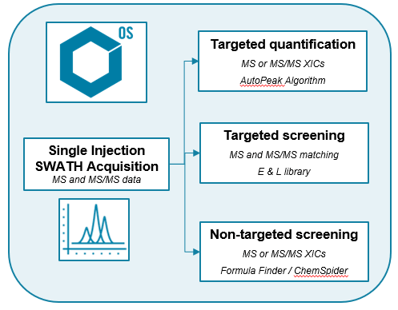
Key features of the SCIEX X500R QTOF System for Extractables and Leachables analysis
- SWATH® Acquisition provides both quantitative and qualitative data for all detectable precursor ions within a single sample injection
- The SCIEX X500R System provides high mass accuracy and accurate isotopic patterns which provides confidence for the identification of a large number of compounds
- SCIEX OS Software provides an efficient and accessible platform for processing the complex data from extractable and leachable studies (Figure 1)
- High quality MS/MS spectra combined with library searching allows for easy targeted screening for known extractable and leachable compounds
- Formula Finder with ChemSpider allows for tentative identification of a precursor ion based on its MS/MS spectra, allowing for a rapid narrowing of candidates for unknown screening applications, which can be crucial in extractable studies
- Accurate quantification of identified compounds from MS or MS/MS data using a targeted quantification workflow
Methods
Standard preparation: Compounds were dissolved in various solvents depending on solubility. These stock solutions were then diluted to create mixed standard solutions between 0.1 and 100 ng/mL in methanol to test the various workflows. Compounds analyzed are shown in Table 1.
Chromatography: Chromatographic separation was performed using the ExionLC™ AD System. The column used was a Phenomenex Kinetex C18 1.7µm, 100 x 2.1mm which provided good resolution of the compounds selected (Figure 2). Details are outlined in the Supplementary Information.4
Mass spectrometry: These experiments were performed using the SCIEX X500R System. Data was collected using SWATH Acquisition, to obtain both quantitative and qualitative data. Data was acquired using SCIEX OS Software. Details are outlined in the Supplementary Information.4
Data processing: Data was processed using SCIEX OS Software and a curated extractable and leachable library created using the standard data collected.

Targeted screening using the library search feature
With any high-resolution analysis, high levels of mass accuracy (MS and MS/MS) are necessary to correctly identify compounds of interest. Ongoing discussion within the industry is leading to a criterion of 5 ppm mass accuracy for high resolution analysis being expected for both MS and MS/MS. In Table 1, the mass accuracy values achieved for all of the compounds analyzed are outlined. This is shown for both the precursor ion as well as a fragment ion from the MS/MS in the SWATH Acquisition data.
Because SWATH Acquisition data contains both MS and MS/MS data, it can be easily processed by the library searching strategy. Using a curated extractable and leachable library, matches are determined between the raw data and previously acquired MS/MS data then, using a set of criteria, are assigned a fit score. Utilizing this feature does not impact quantification. Both features can be used in a single injection, meaning that all necessary data is collected together for both library matching and traditional quantitative analysis. Therefore, it is possible to both identify the compound of interest and calculate the amount of this compound within the sample solution. See Figures 3 and 4 for more on the library search feature.
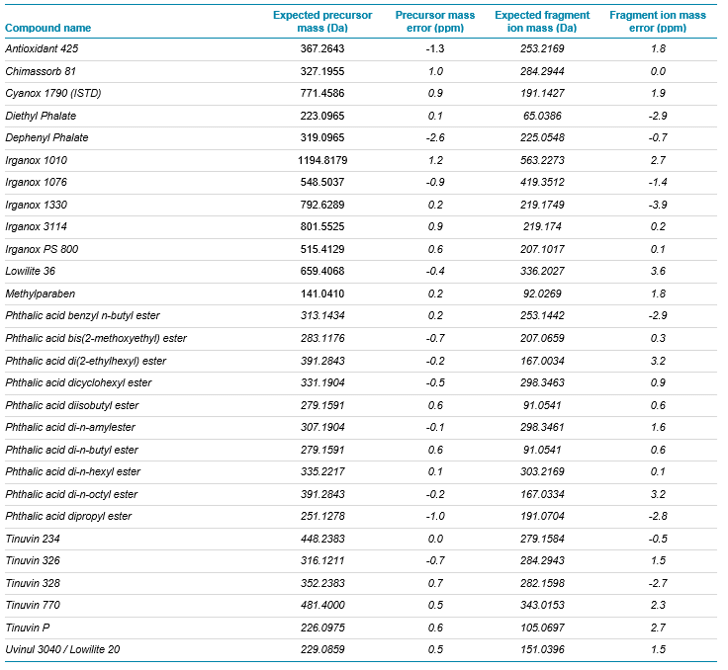
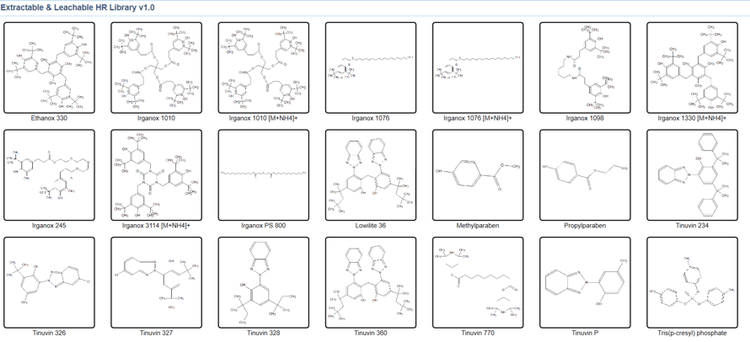
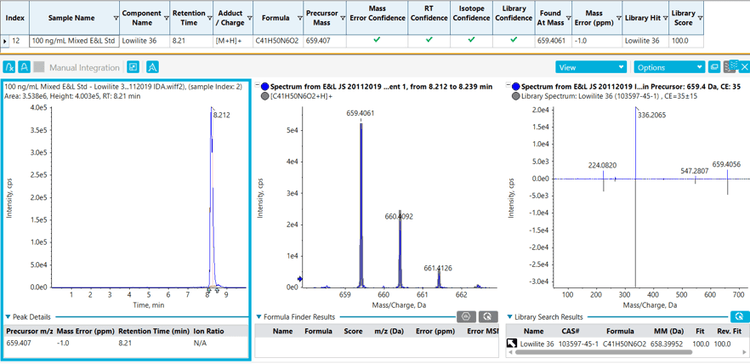
Non-targeted screening utilizing ChemSpider integrated with SCIEX OS Software
While many compounds can be easily identified using a library search approach, additional extractables in the sample that were not in the curated library will have to be found by a second approach, namely non-targeted screening. It is important to have powerful software for this approach as it can be a challenging task to identify compounds of interest.
SCIEX OS Software offers an integrated two-step approach. First, Formula Finder is used to propose potential chemical formulas for features found in the sample from a non-targeted peak finder, using molecular weight, isotope pattern and MS/MS information (Figure 5). Next, these chemical formulas are used to interrogate the vast ChemSpider chemical library. The ChemSpider information is brought back into the software for manual assessment to determine which is most likely to be the compound of interest (Figure 6). Using the chemical structures returned from ChemSpider, the user can interrogate the results by matching the proposed fragment ions with the observed fragment ions in the SWATH Acquisition data. This can save time by giving the user an interactive tool for identifying the unknown compound.
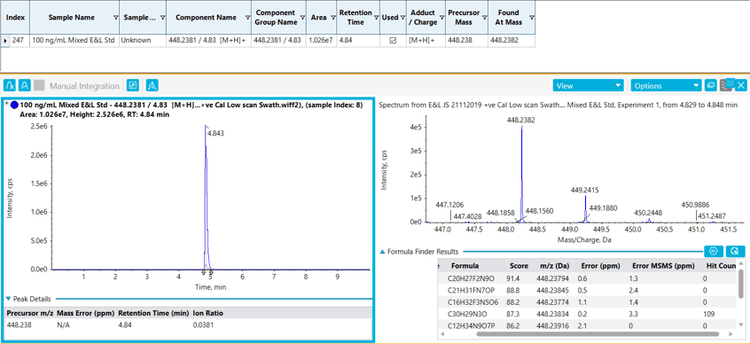

Quantitative analysis
Now that the compounds in the extractable or leachable sample have been identified, they can now be quantified with high levels of precision and accuracy. These analytical attributes, along with sensitivity, are paramount to achieving a robust and repeatable method of analysis. The quantitative detection limits for the selected compounds were determined and are shown in Table 2. The precision (%CV) at the LLOQ and at 10x higher concentration over the LLOQ is also shown. AutoPeak integration algorithm was used which provides reproducible peak integration with minimal manual integration.
As well as sensitivity and precision, linearity and accuracy are also important when performing quantitative analysis. The results for selected compounds are shown in Figure 8 and include linearity, %CV and accuracy values at each point of the calibration curve analyzed.
Ion ratio criteria, in addition to the other quantitative criteria that have been outlined, are also important in determining whether the correct peak is being integrated. It can also serve as an indicator of matrix effects in real samples. Within SCIEX OS Software, ion ratios across the dataset are automatically determined and can be rapidly evaluated. In Figure 7, it can be seen how SCIEX OS Software incorporates ion ratio information into the results table by using symbols and colors so that evaluation can be quickly and efficiently performed. Tolerances can be set in the processing method. The ion ratio shown has been based upon the ratio between precursor ion area and a determined fragment ion area.
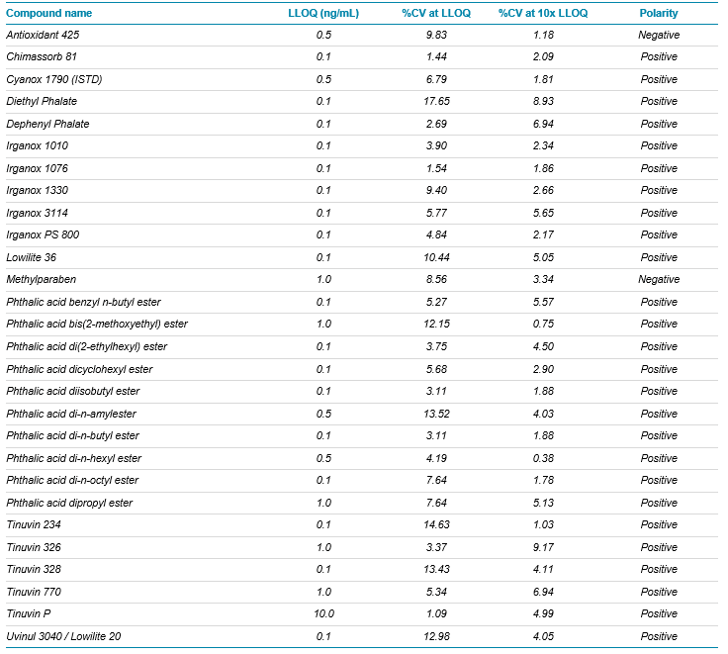
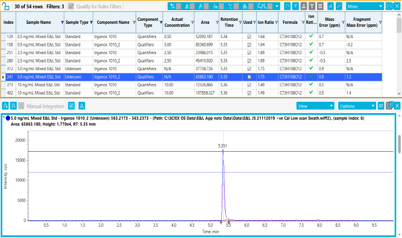
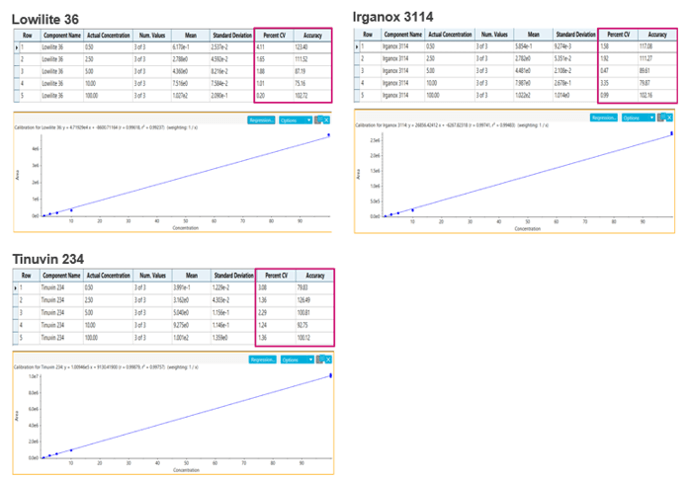
Conclusions
This study has shown that the SCIEX X500R QTOF System delivers high-quality quantitative and qualitative data for extractable and leachable analysis.
- Data is acquired using SWATH Acquisition, to obtain both quantitative and qualitative data in a single injection without compromising data quality
- Very high mass accuracy was observed which is very helpful for screening workflows
- Very good linearity, reproducibility and sensitivity was observed from the quantitative experiments
Data processing has also become much more efficient and accessible due to the design and usability of the SCIEX OS Software.
- For targeted screening, library searching is performed using a curated extractable and leachable library, to identify known compounds easily
- For non-targeted screening, ChemSpider integration with SCIEX OS Software provides a much more streamlined approach to this more difficult analysis, and can save the user a vast amount of time and effort in tentatively identifying unknown compounds with a high level of accuracy
- Identified compounds can then be quantified using a targeted strategy with very good sensitivity and reproducibility
- Results are intuitively displayed for fast and easy interpretation
In summary, SWATH Acquisition on the SCIEX X500R System combined with data processing using SCIEX OS Software provides a flexible and streamlined solution for extractable and leachable studies.
References
- USP <661> Plastic Packaging Systems and Their Materials of Construction.
- USP <1663> Assessment of Extractables associated with pharmaceutical packaging/delivery systems.
- USP <1664> Assessment of Drug Product Leachables Associated with Pharmaceutical Packaging/Delivery systems.
- Download the Supplementary Information.
- Extractables and Leachables Analysis of Laboratory Tubing Using a Quadrupole Time of Flight Mass Spectrometer and SWATH® Acquisition on the X500R QTOF System. SCIEX technical note RUO-MKT-02-10601-A.
